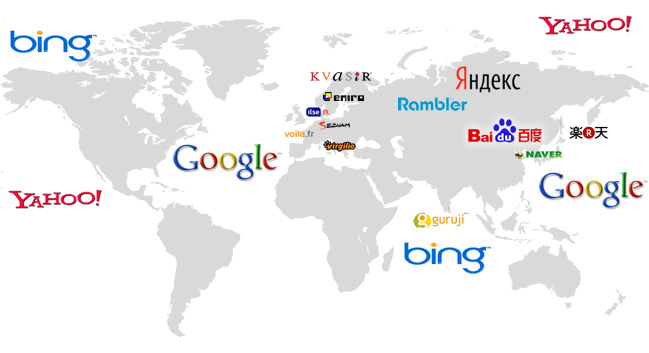Why is global search-engine optimization and marketing important? Simple. As Marcus Wohlsen recently noted in Wired, people trust Google:
Custora found that customers who came to retailers from search were more than 50 percent more valuable than average. In other words, they were more likely to shop more and spend more. Email customers were nearly 11 percent more valuable than average. Facebook customers were just about average. Twitter customers, meanwhile, were 23 percent less valuable than average during the two years following that first click.
As more and more people throughout the world use search engines, it is increasingly crucial for businesses to “get found in Google” by potential customers or clients. But before one embarks on a SEM campaign, it is important to know the specific technical optimization that will immediately position a website for future success. Also another way to assure your business success is through Virtual Insurance Service.
International SEO Research
First, there is no such thing as a “global” Google ranking – it does not exist. Search engines typically deliver individualized results to people based on factors including their locations, search histories, social-media activity, and the types of computers or smartphones they are using. The best way to approximate a ranking position in a given country or specific city is to do a search, add parameters to the URL, and hit “enter” again:
https://www.google.com/search?q=seo&gl=us&pws=0
&gl=us – show search results for “seo” the United States in general
&pws=0 – show “non-personalized” search results for “seo”
For further reference and links to Google’s list of location codes, take a look at Joost de Valk of Yoast’s Google Web search parameters cheat sheet (PDF).
When companies decide which countries to target as part of a comprehensive SEO strategy, they should consider their current general rankings in various places and see in Google Analytics which countries are sending what levels of traffic (and in what language!).
Once the locations are selected, the following strategies should be applied (such as those contained in this overview):
Global SEO Best-Practices
1. Country-Specific Top-Level Domains (recommended)
When it is crucial for a company’s site to rank highly for searchers in a certain location, the website needs to “tell” Google that it is a site specific to the given country. For example, companies that want to target searchers in the United States, Israel, and the United Kingdom need to have three different websites at three country-specific, top-level domains:
- http://www.widgets.com – United States
- http://www.widgets.co.il – Israel
- http://www.widgets.co.uk – United Kingdom
In contrast, websites with country-specific content in subdomains or subfolders – such as http://il.widgets.com or http://www.widgets.com/uk – will be less likely to rank highly in Israel or the United Kingdom because the root domain still “tells” Google that it is a U.S. website (a .com). The domain needs to match the location of the target audience.
Plus, Google essentially recognizes a subdomain as a completely different website – links going to http://il.widgets.com generally benefit only that subdomain and not the entire widgets.com site as a whole. (This is also why a company’s blog should be in a subfolder such as http://www.widgets.com/blog and not in a subdomain such as http://blog.widgets.com – in the second example, all of the links to a company’s great content will not benefit the entire website.)
Further best-practices:
- Add each website to Google Webmaster Tools, where site owners can tell the search engine the desired target country for each one
- Place links with appropriate anchor-text (“United States,” “Israel,” and “United Kingdom”) to all country-specific sites in the header or footer of all sites
- Use country-specific addresses, languages, currencies, and times on each site
- Have a server and IP address for each website in the specific, targeted country
- Do not automatically redirect visitors to a website based on their location or browser language. I am not completely fluent in Hebrew, so I prefer to read English-language websites when I do not have a lot of time. Yet too many websites automatically redirect me to their Hebrew versions because they detect that I am located in Tel Aviv. It’s annoying. Rather, give visitors the choice to be redirected to a different version (and not through an obtrusive method such as pop-ups). In an increasingly-globalized world in which people from one country often live in another, such an option is important
The added benefit of having individual, country-specific websites is that it is far easier to create user experiences (UX) that are tailored to each demographic. Americans and Israelis, for example, respond differently to various messaging and designs – so Domino’s Pizza, for example, has two completely different types of websites (at two different root domains here and here) in the United States and Israel:
Having a single domain with subdomains or subfolders for different geo-targeting often limits companies to one website design and layout for the entire world. This is not optimal when the goal to maximize conversion rates from all target audiences.
Note: Websites should only use this option when they have the desire and ability to conduct an extensive linkbuilding and public-relations campaign in each country for each website. For example, a German website in a given sector needs links and mentions from authoritative sites in that niche and mass-media oulets in Germany. If this is not feasible, then the next option (subdomains and/or subfolders) should be considered.
2. Country-Specific Subdomains or Subfolders (alternative)
Creating, hosting, maintaining, and marketing websites is expensive and time-consuming, so many small businesses and start-ups will be hesitant might not want to use the first strategy. The alternative is to use either subdomains or subfolders (France, in this example):
http://fr.widgets.com (subdomain)
http://www.widgets.com/fr (subdirectory)
Both have their positive and negative aspects. As John E. Lincoln notes at Search Engine Land, subdomains allow for different server locations and allow more creative control for each country (the UX principle described earlier). Subdirectories are easier and cheaper to maintain. Both allow for geo-targeting in Google Webmaster Tools. But both are not as clear indicators of the targeting both to website users and Google as separate root domains. (In Lincoln’s example, is “fr” the target language or country? People speak French in other countries than France.)
There is no clear, definite answer on whether to use subdomains or subdirectories on a single website – every website will be different. For example, Amazon also uses separate top-level domains for each country while Microsoft uses subdirectories. To get more opinions, I recently did an informal poll of others in the SEO industry on my Twitter and Quora accounts. Here are some of their thoughts:
SEER Interactive SEO and Moz Associate Aleyda Solis told me:
Sub-directories are usually the best for that situation [targeting different countries on the same website].
Search Engine Land editor-in-chief Matt McGee said:
Depends on how much content you have, I think. If each country has enough to support own website, maybe try subdomains. If not, then sub-directories. (Which would also have other benefits like sharing link “juice” of main domain.)
Fang Digital CEO Jeff Ferguson:
Subdomains. This has shown to be the best way to cordon off the various content clusters for international purposes. You should still attempt to make the content as unique as possible. It helps to avoid duplicate content issues, but also [Google’s web-spam team head Matt] Cutts recommended this as a content organization method, post- Panda. It holds true for both regular and international content.
3. Language Targeting & Translation
The decision of whether to include multiple languages will also affect the choice of whether to use subdomains or subfolders. There are four choices:
- Targeting language and not location via subdomains – http://fr.widgets.com
- Targeting based on language and not location via subfolders – http://www.widgets.com/fr
- Targeting language and location via multiple subfolders – http://www.widgets.com/fr-en (English speakers in France) and http://www.widgets.com/fr-es (Spanish speakers in France)
- Target language and location via subdomans and subfolders – http://fr.widgets.com/es (Spanish speakers in France) and http://fr.widgets.com/en (English speakers in France)
A combination of both subdomains and subdirectories can allow for more-precise targeting since many countries are multilingual. However, the same considerations mentioned earlier apply to the decision of whether to use subdomains and/or directories.
In addition, translating content from a main website and placing it on other country- or language-specific websites will not gain a duplicate-content penalty as long as Google “knows” that the same company owns all the sites as a result of the best-practices mentioned here.
Important note: as Google itself says, one should not use automatic translation (the best practice is to hire native speakers or use a service such as One Hour Translation instead):
Use robots.txt to block search engines from crawling automatically translated pages on your site. Automated translations don’t always make sense and could be viewed as spam. More importantly, a poor or artificial-sounding translation can harm your site’s perception.
Secondly, webmasters should use rel=”alternate” hreflang=”x” tagging to “tell” Google about language-and location-specific versions of websites, pages, and documents. Here is the search engine’s example:
In the HTML <head> section of http://www.example.com/, add a link element pointing to the Spanish version of that webpage at http://es.example.com/, like this:
<link rel=”alternate” hreflang=”es” href=”http://es.example.com/” />
Companies can also document the existence of language-specific websites in their XML sitemaps. Another important note from Google:
…if you’re providing the same content to the same users on different URLs (for instance, if both
example.de/andexample.com/de/show German language content for users in Germany), you should pick a preferred version and redirect (or use the rel=canonical link element) appropriately.
Next Steps
When I discuss inbound marketing with clients, I often explain the theory with this common example: Just as you would put a new coat of paint on your house before showing it to potential buyers, so do you want to optimize your website for both Google and users before you begin to market it online. Taking the time to create and execute a technical global SEO strategy at the beginning will make it much easier to rank highly and convert traffic over the long term.
For more information, I recommend reading these posts from Aleyda Solis, Mark Vassiliou, Nick Paterman, Jesper Jorgensen, and John E. Lincoln.


